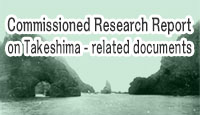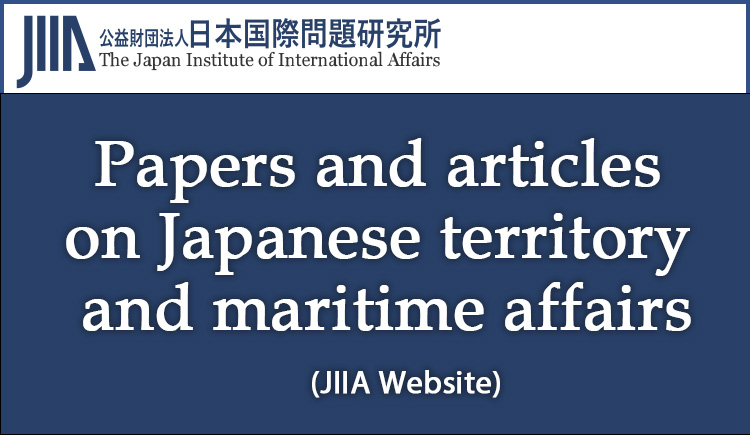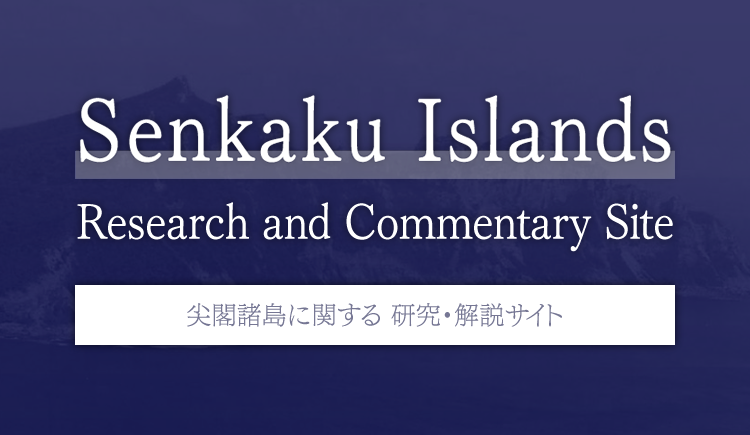The documents and materials published on this website were collected, researched, and prepared with advice from experts, as a part of a Government-commissioned project. The contents of this website do not reflect the views of the Government. Links to external sites (domains other than https://www.cas.go.jp) are not under the management of this site. For linked websites, please check with the organization/group that manages the website for the link in question.
Analysis of claims by other countries
5. Interpretation according to a rule for compiling records of geography
The sentence in Sejong Sillok Jiriji “The two islands are not far apart, and they can be seen if the weather is clear” may literally mean that the two islands of Usan and Mureung are not far apart from each other and thus visible on a clear day, as the ROK interprets it. In a historical context, however, the sentence may be interpreted differently. Provinces were requested to compile records of geography in line with a certain rule so that the central government could put together the provincial geography and establish the geography for the entirety of Korea. According to Gyeongsang-do Jiriji (Geography of Gyeongsang Province, 1425) (see section 3 above), the description of the islands should include “how far they are distant from the land and whether there are inhabitants cultivating the land.” The book goes on to describe Chuksan Island as “By water two hundred bo from the land. No field to be cultivated.”5 This rule is not directly for Sejong Sillok Jiriji, but if one reads in conformity with this rule, there is a possibility that the sentence “The two islands are not far apart, and they can be seen if the weather is clear” describes the distance from land. That is, although the exact value is unknown, the two islands Usan and Mureung are located at a distance visible on a clear day from the Korean Peninsula. Actually, Ulleungdo is visible but Takeshima is not, which means Usan is not Takeshima.
Note 5
『慶尚道地理志・慶尚道続撰地理誌』朝鮮総督府中枢院, 1938, p. 19. See SHIMOJO Masao下條正男『竹島は日韓どちらのものか』文春新書, 2004, pp. 162-166.
6. Confirmation by Sinjeung Dongguk Yeoji Seungnam
That the island visible on a clear day is Ulleungdo, not Takeshima, becomes still more apparent when one consults Sinjeung Dongguk Yeoji Seungnam (Revised and Augmented Survey of the Geography of Korea, 1531), which the MOFA-ROK pamphlet refers to (section 2, underlined part (3) above).6 The article on “Usando Ulleungdo” reads as follows: <For the original text, see Document 2.>
Usando Ulleungdo – Also called Mureung or Ureung. The two islands are located in the sea due east of the prefecture. Three peaks, high and steep, hold up the sky. The southern peak is somewhat lower. The trees on the tops of the mountains and the shore at the foot of mountains can be vividly seen if the weather is clear. Can be reached by sailing two days with the wind. It is also said that originally Usan and Ulleung were one island. The land is a hundred ri square.
As cited above, Sinjeung Dongguk Yeoji Seungnam modified Sejong Sillok Jiriji’s article “The two islands are not far apart, and they can be seen if the weather is clear” to read “Three peaks, high and steep, hold up the sky. …The trees on the tops of the mountains …can be vividly seen if the weather is clear.” That is, while maintaining the sentence “The two islands are located in the sea due east of the prefecture,” the sentences that follow are undoubtedly about Ulleungdo alone, and state that the trees on the tops of the mountains are visible on a clear day. (Takeshima is a rock formation on which no trees grow.)
Note 6
『新増東國輿地勝覧』巻四十五, Seoul: 東國文化社, 1958, p. 814.
Document 2
『新増東国輿地勝覧』巻四十五蔚珍県山川条
Uljin prefecture,
view image >>
<Transcription>
于山島 欝陵島 [分注]一云武陵 一云羽陵 二島在縣正東海中 三峯岌嶫撑空 南峯稍卑 風日清明 則峯頭樹木及山根沙渚 歴歴可見 風便則二日可到 一説于山欝陵本一島 地方百里 新羅時恃險不服 智證王十二年 異斯夫爲何瑟羅州軍主 謂于山國人愚悍 難以威服 可以計服 乃多以木造獅子 分載戰艦 抵其國 誑之曰 汝若不服則即放此獸 踏殺之 國人懼來降 高麗太祖十三年 其島人使白吉土豆 獻方物 毅宗十三年 王聞欝陵島地廣土肥 可以居民 遣溟州道監倉金柔立往視 柔立回奏云 島中有大山 從山頂向東行至海一萬餘歩 向西行一萬三千餘歩 向南行一萬五千餘歩 向北行八千餘歩 有村落基址七所 或有石佛 鐵鐘 石塔 多生柴胡 蒿本 石南草 後崔忠獻獻議 以武陵土壌膏沃 多珍水海錯 遣使往觀之 有屋基破礎宛然 不知何代人居也 於是移東郡民以實之 及使還 多以珍木海錯進之 後屢爲風濤所蕩覆 舟人多物故 因還其居民 本朝 太宗時 聞流民逃其島甚多 再命三陟人金麟雨 爲按撫使刷出空其地 麟雨言 土地沃饒 竹大如杠 鼠大如猫 桃核大於升 凡物稱是 世宗二十年 遣縣人萬戸南顥 率數百人 往捜逋民 盡俘金丸等七十餘人 而還 其地遂空 成宗二年 有告別有三峯島者 乃遣朴宗元 往覓之 因風濤 不得泊而還 同行一船 泊欝陵島 只取大竹大鰒魚 回啓云 島中無居民矣
『新増東國輿地勝覧』八道總圖 “Map of Eight Provinces,” Sinjeung Dongguk Yeoji Seungnam
view image >>
7. Does Korea’s effective control over Takeshima date back to the Silla period?
Here, the second assertion will be examined. The ROK claims, “In Sejong Sillok Jiriji, 1454, it is recorded that Ulleungdo (Mureung) and Dokdo (Usan) had been territories of Usan-guk (Usan State), which was subjugated to Silla (former kingdom of Korea) in the early 6th century (AD 512), indicating that Korea’s effective control over Dokdo dates back to the Silla period” (section 2, underlined part (2) above).
It is not true that Sejong Sillok Jiriji says “Ulleungdo (Mureung) and Dokdo (Usan) had been territories of Usan-guk (Usan State).” The Sejong Sillok Jiriji article speaks only about Ulleungdo. The sentences “Called Usan State in the Silla period. Another name is Ulleungdo. The land is a hundred ri square.” are citations from Samguk Sagi7 (The History of Three Kingdoms) (1145) . An article in “the History of Silla part 4, the 6th month of the 13th year of King Jijeung’s reign” states:
Usan-guk (Usan State) is in hae-do (island in the sea) due east of Myeong Ju [present Uljin prefecture]. Another name is Ulleungdo. The land is one hundred ri square. <For the original text, see Document 3.>
The story about Isabu making the people of Usan State surrender using wooden beasts of prey is also derived from Samguk Sagi, which states that Usan State’s other name is Ulleungdo. The story of the islanders who presented products in the 13th year of Goryeo Taejo is about Ulleungdo. Again, the island on which Kim Yu-Rib reported to have seen a big mountain and vestiges of village in the 13th year of King Uijong, and lastly, the island where Kim Rin-U reported that the land was fertile and big bamboos grow is Ulleungdo, not Takeshima, which is a rock formation. Sejong Sillok Jiriji cannot be a ground for the Korean assertion that its effective control over Takeshima dates back to the Silla period.8
Note 7
Samguk Sagi『三國史記』is the first history book in Korea, compiled by Kim Bu-Sik金富軾and others in the 23rd year of Goryeo Injong高麗仁宗 (1145). It records the history of Silla新羅, Goguryeo高句麗 and Baekje百濟 (TAGAWA田川, op. cit. note 3 above). 『三國史記』學習院東洋文化研究所 (學東叢書1), 1964, p. 33-34.
Document 3
『三國史記』新羅本記第四 智證王十三年条
Samguk Sagi, Silla pt.4, the 13th year of King
view image >>
<Transcription>
十三年夏六月 于山國歸服 歳以土冝爲貢 于山國 在溟州正東海島 或名鬱陵島 地方一百里 恃嶮不服 伊飡異斯夫 爲何瑟羅州軍主 謂于山人愚悍 難以威來 可以計服 乃多造木偶師子 分載戰舩 柢其國海岸 誑告曰 汝若不服 則放此猛獸踏殺之 國人恐懼則降
Note 8
The ROK claims that Dongguk Munheon Bigo (Reference Compilation of Documents on Korea)『東國文獻備考』(1770) states, “Ulleung [Ulleungdo] and Usan [Dokdo] are both territories of Usan-guk [Usan State], and Usan [Dokdo] is what Japan refers to as Matsushima [the old Japanese name for Dokdo]” (section 2, underlined part (4) above). While the Korean claim might link Dongguk Munheon Bigo with Sejong Sillok Jiriji, it is not appropriate to interpret a document from the 15th century by simply applying a writer’s opinion from the 18th century. On Dongguk Munheon Bigo, see SHIMOJO下條, op. cit. note 5 above, pp. 100-103.
8. Conclusion: Usan[do] in Sejong Sillok Jiriji is Ulleungdo
In addition, the island Kim Rin-U visited as “Appeasing Officer” (last part of the article of Sejong Sillok Jiriji, see section 3 above) is described as “Usando” (Usan island) in Taejong Sillok (Annals of King Taejong’s Reign).9 In the second month of the 17th year of King Taejong (1417) it is recorded: <For the original text, see Document 4.>
Appeasing officer Kim Rin-U returned from Usando. He presented products such as big bamboo, sea lion skin, unprocessed paper mulberry, cotton, and Geom-bak tree, and brought back three inhabitants. The number of households on the island is about 15, the population is 86, men and women altogether. …
To sum up, the following appears to be the case. That is, in the Silla period, there was an Usan State on Ulleungdo (Ulleung Island). As time passed, people began to consider “Usan” to be the island’s name, and it was written in Sejong Sillok Jiriji, “Usan, Mureung (Ulleung), two islands, are located in the sea due east of the prefecture. The content of the article, however, is entirely about Ulleungdo, as a matter of course. The article on Kim Rin-U in Taejong Sillok is an example of Usando (Usan island) meaning Ulleungdo. The Usan in Sejong Sillok Jiriji is not Takeshima but an imaginary island or Ulleungdo.
<Postscript>
There are Korean maps made in and after 18th century in which Usan (Usando) is drawn to the east of Ulleungdo. The Usan island of this group is an islet adjacent to Ulleungdo that is called Jukdo in Korea now. As Korean officials began to visit Ulleungdo periodically, knowledge about Ulleungdo increased. They found an islet (located 2 km from it) and assumed it to be Usando. Whereas the “Usando” drawn between the Korean Peninsula and Ulleungdo is an imaginary island (Doc. 2, “Map of Eight Provinces,” Sinjeung Dongguk Yeoji Seungnam), this Usan island depicted to the east of Ulleungdo (Doc. 5) does exist, but it is not Takeshima either.
Note 9
Taejong Sillok『太宗實錄』太宗十七年二月壬戌条, 國史編纂委員會『朝鮮王朝實錄 二』Seoul: 東國文化社, 1955, p. 146.
Document 4
『太宗實録』太宗十七年二月壬戌条
Taejong Sillok, the 17th year of King Taejong
view image >>
<Transcription>
○按撫使金麟雨 還自于山島 獻土産 大竹 水牛皮 生苧 綿子 檢樸等物 且率居人三名以来 其島戸凡十五 口男女并八十六 麟雨之往還也 再逢颱風 僅得其生
Document 5
Daedong Yeoji-do 14 (Map of Korea, 19th C.?)
view image >>
Takeshima
Research and Commentary Site
- I Comprehensive issues
- II Commentary on themes by historical period
- III Analysis of claims by other countries





